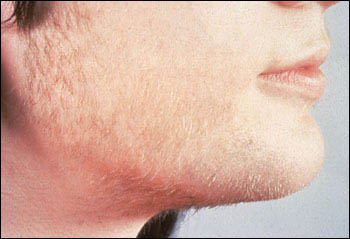The 21-hydroxylase deficiency is the most common congenital adrenal hyperplasia due. Adrenal enzymatic blocks are transmitted in an autosomal dominant fashion.
1- Definitions:
A- Hirsutism:
Is characterized by the existence in women of androgen-dependent hair growth in places where they do not normally exist.
B- hypertrichosis:
Mere exaggeration of normal hair, which depends on the expense of somatic hair (legs, forearm); it does not impose endocrine balance (somatic hair does not monodépendants hor-state).
C- Virilism:
Hirsutism associated with other signs of hyperandrogenism: hoarseness, clitoral hypertrophy, androgenic alopecia, developed muscles.
2- Physiology:
– The 2 main androgens are: Δ4-androstendione and testosterone; their origin is both ovarian and adrenal.Two thirds of the Δ4-androstendione derived from the ovary. 60% of testosterone is of peripheral origin (liver, skin, adipose tissue) by converting the Δ4-androstendione, DHA and SDHA.
– In terms of target tissues, testosterone is converted by 5-α reductase into dihydrotestosterone.
– Androgens are synthesized in the fascicular and reticular zones of the adrenal cortex in response to ACTH. In the ovary, androgens are produced in the theca interna, under the influence of LH. They are largely aromatized to estrogen in the granulosa cells through FSH.
– The estrogen and thyroid hormones stimulate the hepatic synthesis of the TeBG (Testosterone Estradiol binding globulin).
Three mechanisms may be responsible for hirsutism:
– Excess of exo or endogenous androgen
– Decreased TeBG
– Increased peripheral sensitivity to androgens: by increasing the activity of 5-α reductase.
3- Plasma Hormone Assays:
* In the first line:
– Total Testosterone: a rate ≥ 1.5 ng / mL -> tumor etiology
– SDHA -> its significant increase to the suspicion of adrenal origin
– The 17-OH-progesterone: the rate> 5 ng / mL for the proposition deficient 21-hydroxylase
* In the second line:
– Δ4-androstenedione -> better reflects androgen production
– The 3α-glucuronide androstanediol (rate correlated to peripheral androgen consumption).
– Three parameters have no interest: DHT (primarily reflects liver 5α-reduction); DHA and urinary 17-ketosteroids.
* Test at Synacthene: it is with the GnRH test the single dynamic test to do. It should be used when a block suspicious late-onset adrenal; high levels of 17-OH-hydroxylase after injection Synacthene evidence to suggest the presence of a deficit 21-hydroxylase;
4- Etiology:
Polycystic ovary syndrome
Ovarian tumors androgénosécrétantes: arrhenoblastoma
Pseudotumoral lesions of the ovary:
5- Treatment:
– Cyproterone acetate (Androcur®) -> antiandrogen
– Hydrocortisone -> inhibits the secretion of ACTH
– Spironolactone -> antiandrogen
– Finasteride -> inhibitor of 5α-reductase


You must be logged in to post a comment.